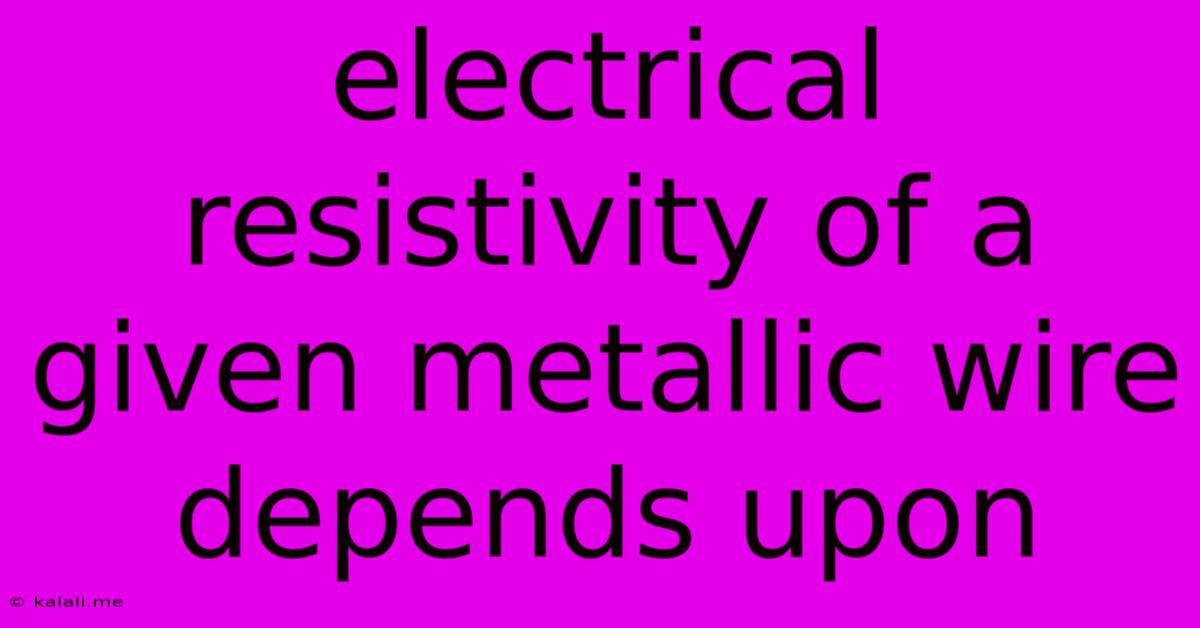Electrical Resistivity Of A Given Metallic Wire Depends Upon
Kalali
Jun 12, 2025 · 3 min read

Table of Contents
Electrical Resistivity of a Metallic Wire: Factors at Play
The electrical resistivity of a metallic wire is a crucial property determining its ability to conduct electricity. Understanding the factors influencing this resistivity is essential for selecting appropriate materials for various applications, from power transmission lines to microelectronics. This article delves into the key parameters affecting the electrical resistivity of a metallic wire.
A material's resistivity determines how strongly it opposes the flow of electric current. Lower resistivity means better conductivity. In the case of a metallic wire, several factors influence this crucial property. We'll explore these factors in detail, explaining their impact and the underlying physics.
1. Temperature
Temperature is arguably the most significant factor affecting the electrical resistivity of a metallic wire. As temperature increases, the atoms within the metal lattice vibrate more vigorously. These increased vibrations disrupt the flow of free electrons, the charge carriers responsible for electrical conduction. This increased scattering of electrons leads to higher resistivity. This relationship is generally linear for many metals over a moderate temperature range, described by the following equation:
ρ<sub>T</sub> = ρ<sub>0</sub>[1 + α(T - T<sub>0</sub>)]
Where:
- ρ<sub>T</sub> is the resistivity at temperature T
- ρ<sub>0</sub> is the resistivity at a reference temperature T<sub>0</sub>
- α is the temperature coefficient of resistivity
Important Note: There are exceptions to this linear relationship, especially at very low or very high temperatures. At extremely low temperatures, some metals exhibit superconductivity, where resistivity drops to virtually zero.
2. Material Composition
The inherent atomic structure and electron configuration of the metal significantly impact its resistivity. Different metals possess different numbers of free electrons and varying degrees of crystal lattice imperfections. Metals with a higher number of free electrons generally exhibit lower resistivity. The purity of the metal also plays a crucial role; impurities scatter electrons, increasing resistivity. Alloying, a process of combining different metals, can alter the resistivity, often increasing it due to the introduction of impurity atoms that act as scattering centers. This is why alloys are sometimes preferred in specific applications where higher resistivity is needed.
3. Wire Dimensions (Length and Cross-sectional Area)
While resistivity is an intrinsic property of the material, the resistance of a wire depends on its dimensions. Resistance (R) is directly proportional to the length (L) and inversely proportional to the cross-sectional area (A) of the wire. This relationship is expressed by:
R = ρL/A
A longer wire offers more resistance to electron flow, while a wire with a larger cross-sectional area provides more pathways for electrons, reducing resistance. Therefore, while resistivity remains constant for a given material and temperature, the overall resistance of the wire is adjustable through its physical dimensions.
4. Physical State and Defects
The physical state of the metal, such as whether it's annealed (heat-treated to relieve internal stresses) or cold-worked (deformed at lower temperatures), also influences its resistivity. Cold working introduces lattice imperfections, like dislocations, which act as scattering centers for electrons, increasing resistivity. Annealing reduces these imperfections, lowering resistivity. Other defects like grain boundaries can also contribute to increased electron scattering and higher resistivity.
5. Presence of Magnetic Fields
The application of an external magnetic field can affect the resistivity of a metallic wire, a phenomenon known as magnetoresistance. This effect arises from the interaction of the moving electrons with the magnetic field, altering their trajectories and increasing the scattering rate. The magnitude of this effect depends on the strength of the magnetic field and the type of metal.
In conclusion, the electrical resistivity of a metallic wire is a multifaceted property determined by a complex interplay of factors including temperature, material composition, dimensions, physical state, and external magnetic fields. A thorough understanding of these factors is critical for the design and application of electrical components and systems across diverse fields of engineering and technology.
Latest Posts
Latest Posts
-
Which Of The Following Is A Secondary Source
Jun 13, 2025
-
What Is The Lcm Of 6 8 And 12
Jun 13, 2025
-
The Magnetic Field Of An Electromagnetic Wave Is Given By
Jun 13, 2025
-
Whats The Square Root Of 361
Jun 13, 2025
-
Who Coined The Term Intelligence Quotient
Jun 13, 2025
Related Post
Thank you for visiting our website which covers about Electrical Resistivity Of A Given Metallic Wire Depends Upon . We hope the information provided has been useful to you. Feel free to contact us if you have any questions or need further assistance. See you next time and don't miss to bookmark.